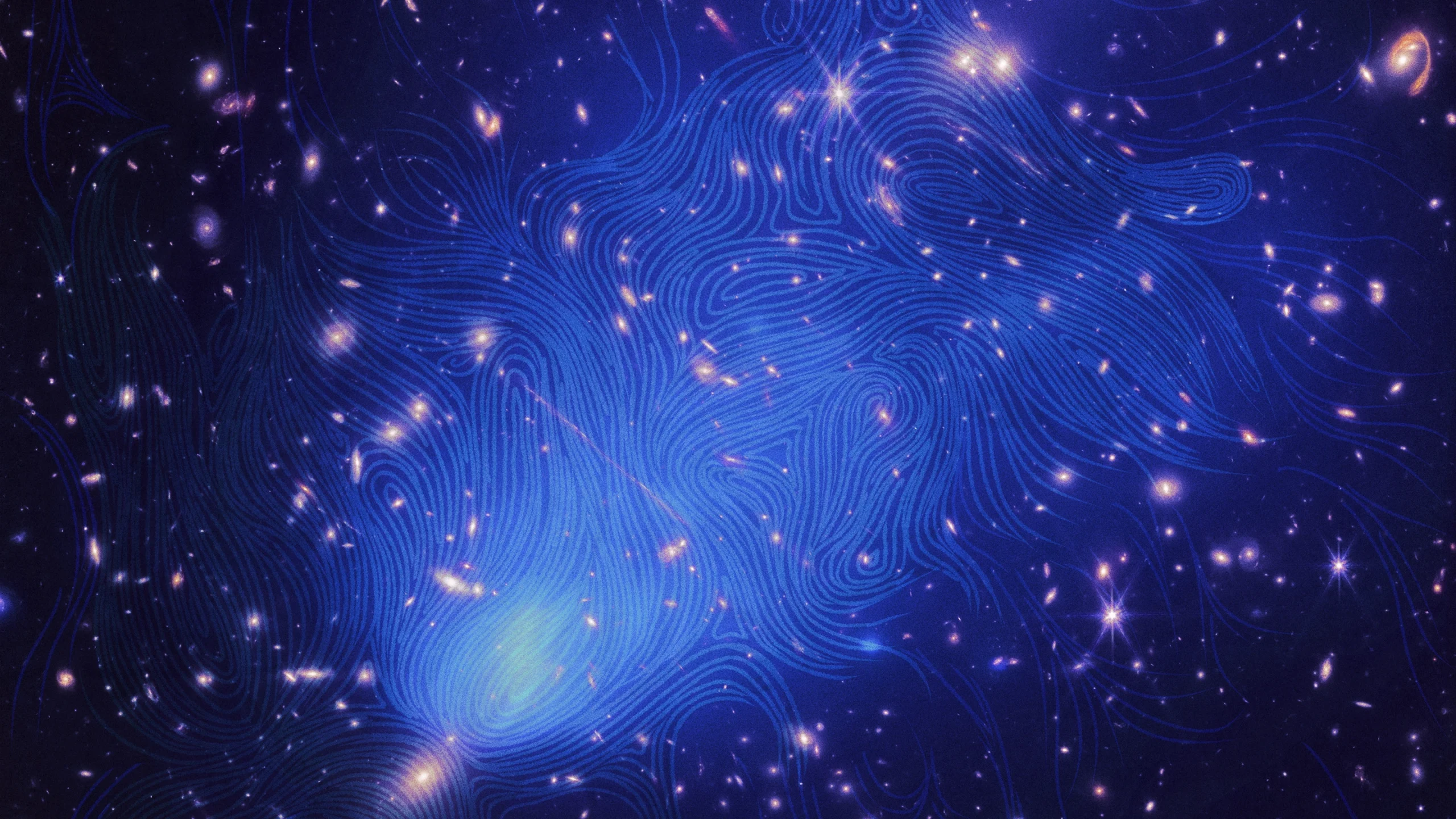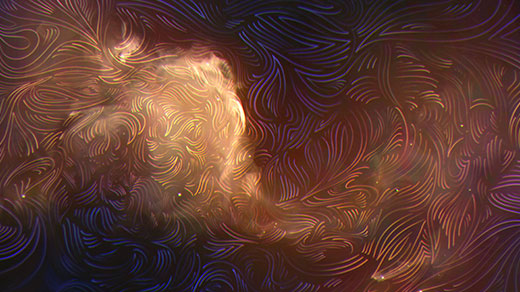Radio Maps May Reveal the Universe’s Biggest Magnetic Fields

Using radio waves, astronomers made a map of the magnetic field within the El Gordo cluster of galaxies, which spans 6 million light-years.
NASA/ESA/CSA, Yue Hu
Introduction
By making maps of the magnetic fields hidden inside massive galaxy clusters, astronomers are getting closer to finding the origin of cosmic magnetism.
“These are the first maps of the detailed structure of magnetic fields on an unprecedentedly large scale,” said Alexandre Lazarian, an astronomer at the University of Wisconsin, Madison, and a co-author on the paper describing the maps, published today in Nature Communications.
Lazarian and his colleagues studied five galaxy clusters, each spanning millions of light-years. They made the maps using a technique he devised called synchrotron intensity gradient (SIG) mapping, which relies on radio observations to work out which way a cluster’s magnetic field points at a given location. By applying the same technique across an entire cluster, the researchers say they can construct a complete map of its magnetic fields. The results, if confirmed, would show that there’s a previously undetected order to magnetic fields in giant structures.
Magnetism is ubiquitous in the universe. We see it from the smallest scales on Earth to the universe’s largest, where it sculpts cosmic structures such as stars and the interstellar medium. Magnetism is also crucial for life as we know it, influencing chirality at a molecular level and crafting the protective shield that encompasses Earth. But a big unanswered question has been where cosmic magnetism originated. Some scientists favor a primordial explanation, with magnetism arising in the first moments after the Big Bang with the other fundamental forces. Others favor a later arrival, with magnetism arising after hundreds of millions of years and growing from seed magnetic fields produced by objects such as stars and galaxies.
This new mapping technique might offer a solution by allowing astronomers to compare magnetic fields on the very largest scales. But the technique has its own limitations and remains somewhat controversial in the field of large-scale magnetism.
“If it works, it gives you a very observationally inexpensive way of mapping magnetic fields over very large areas of the sky,” said Kate Pattle, an astrophysicist at University College London.
Cosmic Cartography
Scientists typically find cosmic magnetic fields by studying synchrotron radiation — radio emissions produced as a magnetic field bends the path of electrons traveling close to the speed of light. Such observations can also use the orientation of those radio emissions — their polarization — to reveal the orientation of the magnetic fields. But polarization measurements are extremely time-consuming, and work best in denser and dustier regions of a galaxy cluster.
Samuel Velasco/Quanta Magazine
About seven years ago, Lazarian came up with a way to use synchrotron emission alone to reveal the direction of the magnetic field — no polarization needed. The technique uses observations of the changing strength of the radio emission as you move across space, or what researchers call the gradient.
“The gradient in the brightness, the direction in which the image becomes fainter or brighter, relates to the magnetic fields,” said Marcus Brüggen, a professor of astrophysics at the University of Hamburg in Germany who has previously studied large magnetic fields.
In preliminary observations of interstellar space, “everywhere we [looked], we revealed this magnetic field structure,” Lazarian said.
The team then turned to galaxy clusters, which grow as smaller groups of galaxies collide. When these mergers occur, they produce shock fronts that “plow through the [intracluster] medium,” Brüggen said. When magnetic fields interact with those turbulent shock fronts, they produce synchrotron emission. By observing the gradient of that emission, the researchers can infer the direction of the magnetic field, which in turn reflects the mergers that have built these clusters over time.
The method allows Lazarian to survey magnetic fields across the expanse of huge galaxy clusters, including the diffuse intergalactic space within the structure where polarization measurements are not possible. To make their maps, the team targeted five galaxy clusters, including El Gordo — a well-studied clump of hundreds of galaxies that stretches 6 million light-years across. They also looked at Abell 2345, 2 billion light-years away, Abell 3376, about a half-billion light-years away, and two others.
Not all scientists are convinced that the strategy accurately tracks the motion of magnetic fields, however. What look like shifts in magnetism-driven synchrotron gradients could just be changes in electron or gas density. The method also relies on a phenomenon known as turbulence in galaxy clusters, where magnetic fields twist and turn together — “a notoriously complex physical process,” said Andrea Botteon, an astrophysicist at the National Institute for Astrophysics in Italy.
Magnetic Life
In the future, Lazarian wants to use SIG — if the technique holds up — to map the magnetism in filaments between galaxies using a vast European radio network called the Low-Frequency Array. If the fields in those filaments are aligned with one another, as they are in clusters, it might suggest a primordial source of cosmic magnetic structure rather than a slow emergence from seed magnetic fields. Such an alignment would be “essentially impossible” for stars and galaxies to create during later cosmic epochs, Brüggen said.
“My hunch,” Brüggen said, “is we will find that magnetic fields were produced early in the universe.”
Divining the origin of magnetism may tell us something about the habitability of the cosmos. Life itself (at least as we know it on Earth) relies on magnetism and its influence on chirality to give the building blocks of life a right- or left-handedness. “If magnetic fields formed at the beginning of the universe, you can form molecules with chirality very early,” Lazarian said. Then, “we can ask the question [of] whether we should expect to see signals of civilizations which formed quite early in the history of the universe.”
He also noted that magnetic fields in galaxy clusters could be the source of some of the highest-energy cosmic rays known to pervade the universe, which still have a mysterious origin. “There’s a big question [about] whether these clusters of galaxies could be the sources of the cosmic rays of the highest energy,” he said, and mapping the fields within clusters could help resolve that question.
The team’s next goal is to observe galaxy clusters that are farther away and further back in time. El Gordo, although immense, only stretches back to when the universe was 6.5 billion light-years old, about half its current age of 13.8 billion years. Upcoming radio telescopes such as the Square Kilometer Array, a vast array of antennas that will be spread across 1 million square meters in South Africa and Australia later this decade, could be powerful enough to apply this type of mapping to clusters that existed when the universe was just 3 billion years old.
“I would like to see what happened in the early universe,” said Yue Hu, a graduate student at the University of Wisconsin, Madison, and lead author on the paper.
But the origin of magnetism in the universe, and all the implications of that answer, will not be solved overnight using this method. “It’s one piece of the puzzle,” Brüggen said. “But it’s a very substantial piece.”






